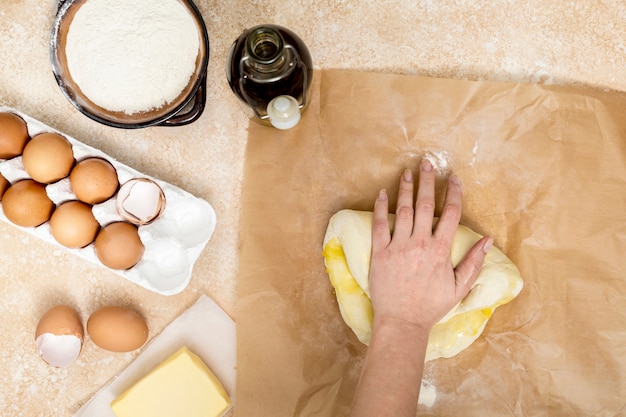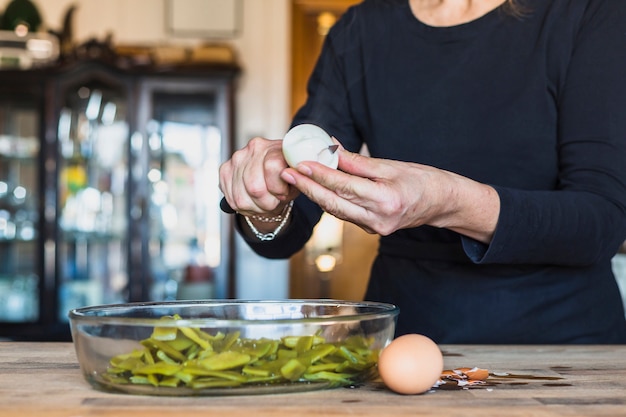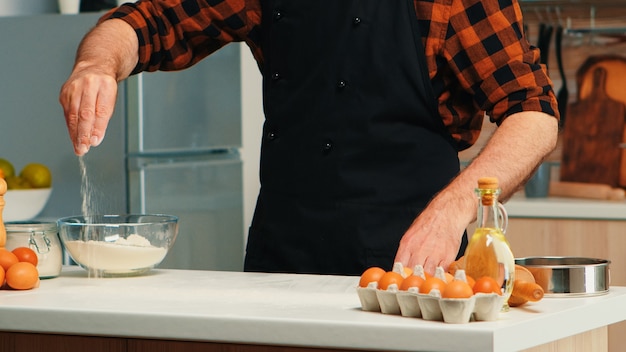We’ve all been there – the triumphant moment of pulling hard-boiled eggs from the pot, only to be met with the dreaded peeling nightmare. Those stubborn bits of shell clinging stubbornly, making a simple task feel like a battle. But I’m here to tell you, friends, there’s hope! After years of peeling frustration, I’ve cracked the code (pun intended, of course!), and I’m ready to share the secrets to achieving those perfectly peelable hard-boiled eggs that everyone envies.
Think of this guide as your ultimate egg-spedition (pun totally intended again!). We’ll cover everything from choosing the right eggs and mastering the boiling process to the art of peeling and some handy troubleshooting tips. And because I believe in the power of personal experience, I’ll be sharing my own tales of triumph and tribulation along the way. So, grab a comfy seat, brew yourself a cuppa, and let's embark on this egg-cellent journey together!
(Part 1) The Egg-cellent Foundation: Choosing the Right Eggs

Before you even reach for the pot, it’s important to understand that not all eggs are created equal when it comes to peeling.
The Egg Factor: What Makes a Good Peeler?
The key to peeling perfection starts with choosing the right eggs. My go-to are always the older ones, the ones that have been sitting in the fridge for a while. You might be thinking, “Older eggs? Won’t they be bad?” Not if you buy them from a reputable source! The air sac inside the egg expands as it ages, which helps the shell separate more easily from the white. So, that carton of fresh eggs you just bought? Leave them in the fridge for a week or so before boiling them.
Fresh vs. Aged: The Age of the Egg
Now, I know you might be hesitant about using older eggs, worried about the smell or texture. Trust me, if you’re buying eggs from a reputable source, the smell will be perfectly fine. And the older egg won’t suddenly go off on you in a week! As long as you keep them properly refrigerated, they’ll be just fine.
Here’s a helpful tip: You can usually tell the age of an egg by its color. Fresh eggs tend to have a darker yolk, while older eggs have a lighter, paler yolk. So, if you’re looking for the perfect peeling experience, opt for those eggs with a paler yolk.
The Size Matters: egg size and Peeling
Another factor to consider is the size of the egg. While not a deal-breaker, smaller eggs tend to peel more easily. Think of it this way: Smaller eggs have a lower ratio of shell to white, meaning there’s less surface area for the shell to cling to. So, if you're aiming for a smooth peel, maybe opt for those little guys.
(Part 2) The Boiling Point: Mastering the Perfect Boil

Now that you’ve got your eggs, it’s time to tackle the boiling process. This is where many people go wrong, rushing the process and ending up with tough, rubbery whites that are a nightmare to peel.
The Cold Start: Bringing the Water to a Gentle Boil
The trick is to start with cold water. Imagine it like this: You wouldn’t throw a delicate flower into a boiling pot of water, would you? It needs to acclimatize gradually. The same principle applies to your eggs. A cold start allows the egg to heat up slowly and evenly, preventing the white from becoming tough and making peeling easier.
Timing is Everything: The Perfect Boil Time
Now, the timing. The internet is full of conflicting advice, but I’ve found a tried-and-true method that works perfectly. Bring the water to a gentle boil, then add the eggs. Once the water returns to a boil, set a timer for 10 minutes. That’s it! No need for fancy techniques or complicated calculations. The exact timing might vary slightly depending on your egg size, but 10 minutes is a good starting point.
The ice bath: Shocking the Egg for Easy Peeling
Once the timer goes off, drain the hot water and immediately plunge your eggs into a bowl of ice water. This shock treatment is crucial for easy peeling. The sudden change in temperature helps the egg white contract, which makes it separate more easily from the shell. It’s a bit like giving your eggs a mini spa treatment!
(Part 3) The Art of the Peel: Unveiling the Perfect Hard-Boiled Egg

You've got your perfectly cooked eggs, now it's time for the grand unveiling.
The Right Tools: A Quick Guide to Peeling Equipment
There are a few different tools you can use for peeling, but my go-to is a trusty spoon. I find that the rounded edge helps to gently pry off the shell without damaging the egg. You can also use your fingers, but be careful not to press too hard, as this can cause the egg white to break.
The Technique: A Step-by-Step Guide to Peeling Perfection
Let’s break down the peeling process step-by-step.
- Crack the shell: Gently tap the egg on a flat surface to crack the shell all over. You want to create a network of cracks, like a spiderweb, that will help the shell come off easily.
- Start peeling: Using a spoon or your fingers, gently pry off a small section of the shell.
- Peel in sections: Work your way around the egg, peeling off small sections of shell. Don’t try to remove the entire shell in one go.
- Roll the egg: As you peel, you can gently roll the egg between your hands to help loosen the shell. This is a great technique for getting rid of any stubborn bits of shell.
- Finish with water: If any stubborn bits of shell remain, simply rinse the egg under cold water. The water will help to loosen the shell, making it easier to remove.
The No-Fuss Method: Peeling Under Running Water
For those who prefer a more hands-off approach, you can also peel your eggs under running cold water. The water helps to loosen the shell and makes it easier to peel. Just hold the egg under a gentle stream of cold water and use your fingers to gently peel off the shell.
(Part 4) Avoiding the Common Pitfalls: Troubleshooting the Peeling Process
Even with the best techniques, there are times when you might encounter a peeling dilemma. Here are some common pitfalls and how to avoid them.
The Rubber-Band Effect: Why Eggs Stick to the Shell
Overcooking is one of the main culprits for sticky shells. If you boil your eggs for too long, the white becomes tough and rubbery, making it difficult to separate from the shell. Remember, the ideal boil time is 10 minutes. Any longer, and you risk a sticky peeling situation.
The Cracked Shell: How to Handle a Broken Egg
A cracked shell can also make peeling a nightmare. If you accidentally crack the egg during the boiling process, the white can leak out, making peeling difficult. The best course of action is to discard the cracked egg and start again. To prevent cracking in the first place, try adding a tablespoon of salt to the boiling water. This can help to strengthen the shell.
The Sticky Situation: Why Eggs Don’t Peel Smoothly
Sometimes, even with the perfect cooking and peeling technique, eggs can be a little stubborn. This is often due to the eggs being very fresh. The white is still tightly bound to the shell, making it difficult to separate. The solution? Add a teaspoon of baking soda to the boiling water. This helps to make the shell more brittle, making peeling easier.
(Part 5) Beyond the Basics: Creative Ways to Use Hard-Boiled Eggs
Now that you have those perfectly peeled hard-boiled eggs, it's time to put them to good use! Don’t limit yourself to just egg salad. There’s a whole world of possibilities waiting to be explored.
A Culinary Canvas: Beyond the Egg Salad
Hard-boiled eggs are incredibly versatile. Think of them as a blank canvas for your culinary creativity. They can be diced into salads, sliced for sandwiches, or even used as a base for delicious deviled eggs.
A Colourful Adventure: Egg Decorating for Celebrations
For a fun activity, try decorating your hard-boiled eggs. Dye them with food coloring, paint them with acrylics, or stick on googly eyes and colorful feathers. You can create adorable little creatures, whimsical designs, or even personalize them for special occasions. The possibilities are endless!
The Protein Powerhouse: Eggs in Salads and Sandwiches
Hard-boiled eggs are a great source of protein, making them perfect for salads and sandwiches. They add a satisfyingly chewy texture and a burst of flavor. Chop them up and add them to a classic chicken salad, or slice them thinly for a refreshing summer salad. They also make a great addition to a hearty sandwich, adding a satisfying crunch and a boost of protein.
From Bites to Bowls: A World of Egg Recipes
For something a little more adventurous, try making deviled eggs. These classic appetizers are a crowd-pleaser, and they’re surprisingly easy to make. Or, if you’re feeling fancy, you can even make a poached egg breakfast bowl. The possibilities are truly endless!
(Part 6) The Science Behind the Peel: Unveiling the Mystery
To truly master the art of peeling, it helps to understand the science behind it.
The Egg Anatomy: Understanding the Shell and White
The shell of an egg is made up of calcium carbonate, a hard, porous material. The white, or albumen, is a protein-rich substance that surrounds the yolk.
The Role of Heat: The Science of cooking eggs
When you boil an egg, the heat causes the proteins in the white to denature and solidify. This process, called coagulation, is what gives the egg its solid texture. As the egg cooks, the white contracts and pulls away from the shell, creating a space between the two.
The Perfect Peel: The Chemistry of Separation
The key to peeling an egg easily is to make sure that the white contracts enough to create a clear separation from the shell. If the egg is overcooked, the white becomes too tough and rubbery, making it difficult to peel. The ice bath after cooking helps to ensure that the white contracts properly, making for a smoother peeling experience.
(Part 7) The Egg-ceptional Experience: Personal Tales of Peeling Triumphs and Tribulations
Now, let’s talk about the personal side of peeling.
From Disaster to Delight: A Confession of Peeling Mishaps
We’ve all had our fair share of peeling mishaps. I remember one particularly disastrous attempt where I ended up with more shell than egg. It was a complete mess! I’m sure you’ve been there too. It’s like those moments when you’re trying to put together a flat-pack furniture, and the instructions are written in a language you don’t understand. You end up with a pile of wood and a lot of frustration.
A Moment of Triumph: When Peeling Goes Right
But then there are those moments when everything goes perfectly. You crack the shell, and it just slides off in one smooth piece. It’s a beautiful thing, a moment of culinary triumph. You feel like you’ve conquered the world, or at least the world of hard-boiled eggs.
From Frustration to Freedom: Embracing the Imperfect Peel
Remember, the journey to perfectly peelable hard-boiled eggs is a process. There will be moments of frustration, moments of success, and moments where you’ll want to throw the entire egg at the wall. But don’t give up! With a little patience, the right techniques, and a bit of good old-fashioned kitchen wisdom, you’ll be peeling like a pro in no time.
(Part 8) FAQs: Answering Your Burning Questions
Here are some of the most common questions I get about hard-boiled eggs.
What if I Don’t Have Ice Water?
If you don’t have ice water on hand, you can still cool down your eggs by running them under cold water for a few minutes. This will help to stop the cooking process and make peeling a little easier.
How Long Can I Keep Hard-Boiled Eggs in the Fridge?
Hard-boiled eggs can be stored in the fridge for up to one week. Make sure to keep them in a container of cold water to prevent them from drying out.
What if My Eggs Are Still Sticky?
If your eggs are still sticky, you can try soaking them in cold water for a few minutes. This will help to loosen the shell and make it easier to peel. You can also try using a different peeling method, such as the rolling technique.
Can I boil eggs in a Microwave?
While you can technically boil eggs in a microwave, it’s not recommended. Microwaving eggs can create uneven cooking and can lead to explosions. It’s best to stick to the traditional boiling method for safer and more consistent results.
What’s the Best Way to Dispose of egg shells?
Egg shells are a great source of calcium and can be added to your compost pile. You can also crush them up and use them to fertilize your plants. If you don’t compost, you can simply throw them in the trash.
I hope this guide has been helpful and that you’re now armed with the knowledge and confidence to conquer those hard-boiled eggs. Happy peeling, everyone!
Everyone is watching

Prime Rib Roast Cooking Time Chart: Per Pound Guide
Cooking TipsPrime rib roast. Just the name conjures images of lavish dinners, crackling fires, and hearty laughter. It’s ...

How Long to Bake Potatoes in the Oven (Perfect Every Time)
Cooking TipsBaked potatoes are a staple in my kitchen. They're incredibly versatile, delicious, and surprisingly easy to m...

Perfect Rice Every Time: The Ultimate Guide to Cooking Rice
Cooking TipsAs a self-proclaimed foodie, I've always been a bit obsessed with rice. It's the foundation of countless cuisi...

The Ultimate Guide to Cooking Asparagus: Tips, Techniques, and Recipes
Cooking TipsAsparagus. The mere mention of this spring delicacy conjures up images of vibrant green spears, crisp and burs...

Ultimate Guide to Cooking the Perfect Thanksgiving Turkey
Cooking TipsThanksgiving. Just the word conjures up images of overflowing tables laden with delicious food, the scent of r...
